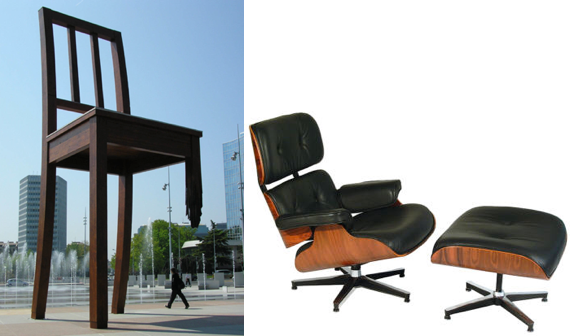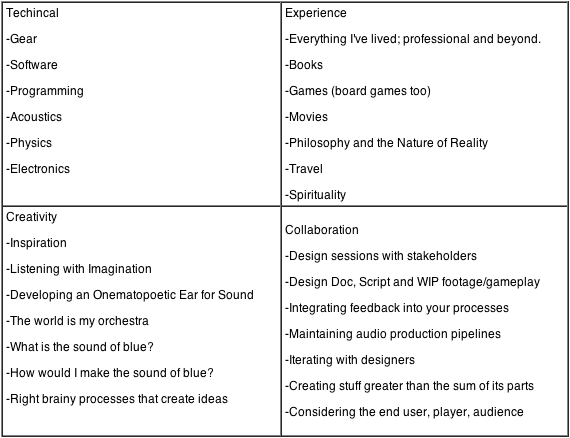Writing a piece on my approach to sound design is trickier than I thought it’d be. Being purely technical isn’t any fun. Creativity needs skill to thrive, so being overly philosophical was just noise. Plus no one works in a vacuum, so how does process and influence fit in? After a few failed attempts this is how it makes sense to me…perhaps it’ll make sense to you. Whether it does or doesn’t I’d love to hear your thoughts. Here we go.
Art vs. Design
A Designer uses skill and creativity to produce works beyond their own specifications and desires. I make this statement so that we all know why we are here. There is a lot of overlap with design and art, but what makes you successful as a designer are the very points where art and design differ. It’s like the difference between these two chairs:
In a prior interview I was asked, “What’s the most important thing about designing a sound?” The answer is, “Knowing why you are designing it.” As with any trade, there are many skills to master, but collaboration is the key piece connecting me to the answer of “why”.
I’ve broken Sound Design into the following skill sets; Technical, Creative, Experience and Collaboration. The first 3 overlap with art. The final…”the collaboration” or “the why”…is where I feel like it differs, and should probably be replaced with something like Vision for an artist.
In general, development for sound designers will start in the upper left corner and progress to the lower right corner. However, I can tell you that all of these quads should be lighting up through out your career. I’ve travelled recently to Africa and Japan and it made a huge impact on how I hear the world. You’ll have natural strengths and weaknesses on this grid…such is the case with me and coding. I’m incompetant as a programmer, and it is something I try to learn every chance I get. This is important because these quads are interconnected. Learning a computer language doesn’t just give me technical skills. Someday it will click for me, and I will be able to explore the other quads deeper.
…and now for my approach
Sound design really is a powerful tool for narrative and experience. Ultimately its my job to advocate, collaborate and excute this on behalf of the project. I look at the overall picture…understand what the project wants to be…hear in my mind what it is missing…and start thinking about how to do it. To help with this, I often imagine the director or producer as the 15 year old kid sitting there playing the game or watching the movie. They are the audience. What experience should they have and what should it sound like?
Now that I’m collaborating and the project’s sound design vision is forming, I can start production. I pull in past experience and intrinsic creativity; then execute based on my technical skills. If you’ll notice, I’m moving backwards on the grid I refered to above. The project collaboration provides the starting point for the other 3 quads. Now comes iteration. What you produce will eventually need to be evaluated…and so we flow back to collaboration…and thus the cycle continues.
Self Serving
The project is paramont in my sound design approach, but there are some wonderful self serving bonuses.
1) An audience or gamer will always have a unique aural experience. Even on projects firmly planted within an established genre, chances are there is something unique about it. You can use that for endless inspiration.
2) It keeps me fresh. With this approach, l often find myself in new territory. That could be recording interesting source material, using a new sound process, designing a new audio mechanic or reading philosophy (thats happening for me now). When I pull something off for a director from a long shot idea or something never tried before…its a thrill.
3) I keep learning. Letting a project challenge you outside of your comfort zone means you’re innovating. Our biz moves fast and breaking new ground is really highly valued
4) Producers and directors want audio to be a part of the creative process for purposes of influencing the design. It used to be that you did a great job when everything sounded amazing, but no one was supposed to notice. On a fundamental level it is still the role of sound to enrich the narrative without being distracting to the experience, but that is the case with ANY aspect of a game or movie. Furthermore, sound is now widely critiqued by media and fans. Its common to see fairly sophisticated analysis of sound in reviews and in fan comments. It becoming increasing clear that audio has graduated to being a part of the greater opinion feedback loop of director/producer> sound designer > reviewer> fan> director/producer > sound designer…etc.
Again I appreciate the opportunity to share my thoughts on sound design. I’d love to learn a little from you, so if you have questions or comments please don’t hesitate to ask.
Written by Andrew Lackey for Designing Sound.



I really like the diagram, it makes me aware of all the skills required to work in this field, and I often find myself spending too much time and attention to the upper left corner instead of the other three. Perhaps this is true for most people?
I really like this short article and I think it’s very sound, not just for a sound design career but for any discipline. I see an extra connection, though, with the top right and bottom left corners: Experience and Creativity, I see them as very strongly linked to one another. Inspiration doesn’t come from thin air contrary to what popular knowledge tells us… (at least in my world view ;) A few of the most creative artists around would be reluctant to admit their influences (borrowing of ideas) but more and more, if you care to get to know them well through interviews and so forth, you’ll see that experience and consumption of culture and art (specially in your domain) in big and varied doses is the best recipe for a fruitful inspiration. The latter requires the former, they are not independent and they key is open-mind-ness. That is my guide, anyways… and my humble tip :)
Thanks for this Andy! So glad you put such a strong emphasis on collaboration which to me is the marrow of successful projects. The ‘Grid’ is great as well, it’s always a noble task to formalize a creative/design driven process and it made for good reflection on the way I work (or what doesn’t work for me; ). Oh and bonus points for using onomatopoeia as an adjective!